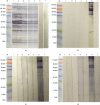Antigenic cross-reactivity between Schistosoma mansoni and peanut: a role for cross-reactive carbohydrate determinants (CCDs) and implications for the hygiene hypothesis
- PMID: 28201853
- PMCID: PMC5343363
- DOI: 10.1111/imm.12711
Antigenic cross-reactivity between Schistosoma mansoni and peanut: a role for cross-reactive carbohydrate determinants (CCDs) and implications for the hygiene hypothesis
Abstract
The antigenic reactivity of constituents of Schistosoma mansoni and peanut (Arachis hypogaea) was investigated to determine whether identical antigenic epitopes possessed by both organisms provided a possible explanation for the negative correlation between chronic schistosome infection and atopy to allergens. Aqueous extracts of peanuts were probed in Western immunoblots with rabbit IgG antibodies raised against the egg, cercarial and adult worm stages of S. mansoni. Several molecules in the peanut extract were antigenically reactive with antibodies from the various rabbit anti-schistosome sera. A pair of cross-reactive peanut molecules at ~30 000-33 000 molecular weight was purified and both proteins were identified by mass spectrometric analysis as the peanut allergen Ara h 1. Anti-S. mansoni soluble egg antigen antibodies that were eluted off the peanut molecules reacted with two S. mansoni egg antigens identified by mass spectrometry as IPSE/α-1 and κ-5. Alignments of the amino acid sequences of Ara h 1 and either IPSE/α-1 or κ-5 revealed a low level of peptide sequence identity. Incubation of nitrocellulose paper carrying electrophoresed peanut molecules, six constituents of other allergic plants and S. mansoni egg antigens in a mild solution of sodium metaperiodate before probing with antibodies, inhibited most of the cross-reactivities. The results are consistent with the antigenic cross-reactive epitopes of S. mansoni egg antigens, peanut and other allergic plants being cross-reactive carbohydrate determinants (CCDs). These findings are novel and an explanation based on 'blocking antibodies' could provide an insight for the inverse relationship observed between schistosome infection and allergies.
Keywords: Schistosoma mansoni; IgG antibodies; antigenic cross-reactivity; cross-reactive carbohydrate determinants; hygiene hypothesis; peanut Ara h 1.
© 2017 John Wiley & Sons Ltd.
Figures





References
-
- WHO . Schistosomiasis: progress report 2001–2011 and strategic plan 2012–2020. www.who.int/iris/bitstream/10665/78074/1/9789241503174_eng.pdf. 2013: pp. 1–81 [accessed on February 25, 2015].
-
- Standley CJ, Mugisha L, Dobson AP, Stothard JR. Zoonotic schistosomiasis in non‐human primates: past, present and future activities at the human–wildlife interface in Africa. J Helminthol 2012; 86:131–40. - PubMed
-
- Caldas IR, Campi‐Azevedo AC, Oliveira LFA, Silveira AM, Oliveira RC, Gazzinelli G. Human schistosomiasis mansoni: immune responses during acute and chronic phases of the infection. Acta Trop 2008; 108:109–17. - PubMed
-
- Allen JE, Maizels RM. Diversity and dialogue in immunity to helminths. Nat Rev Immunol 2011; 11:375–88. - PubMed
MeSH terms
Substances
Associated data
- Actions
- Actions
- Actions
- Actions
- Actions
- Actions
- Actions
- Actions
- Actions
LinkOut - more resources
Full Text Sources
Other Literature Sources

